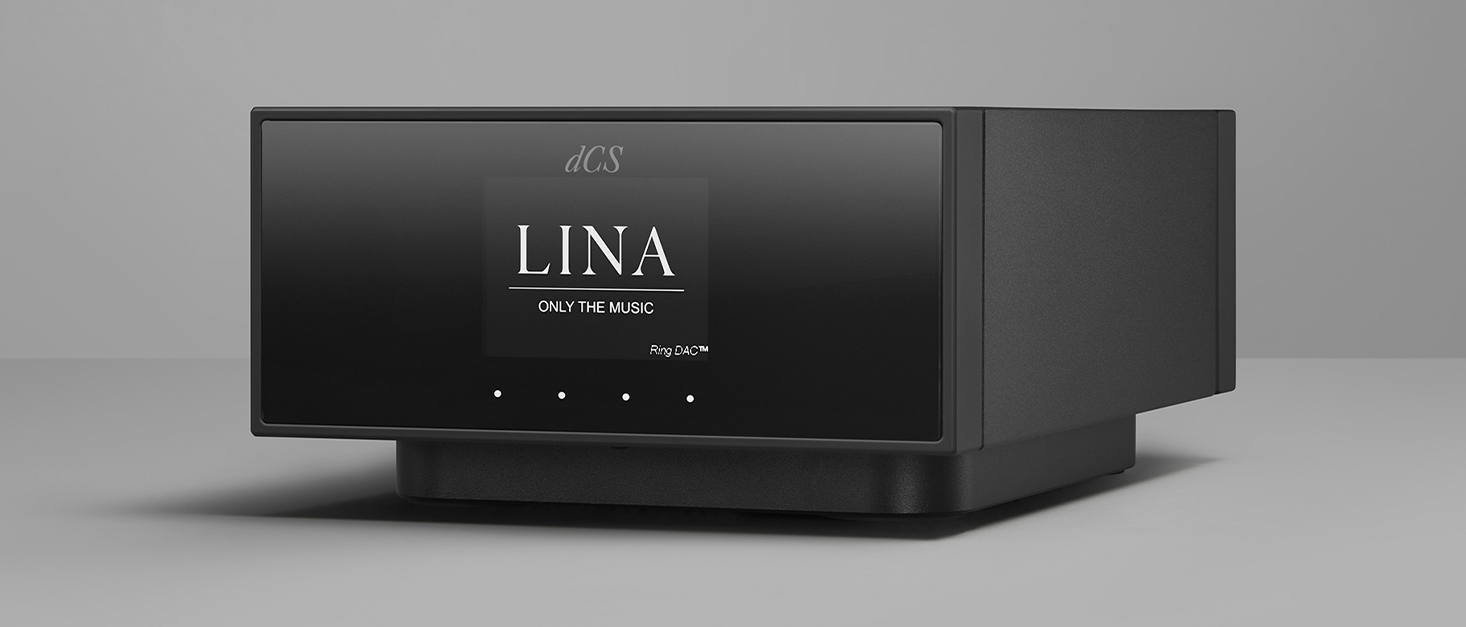
Designing the Lina Network DAC
Here, we reflect on the DAC's design and the unique features and innovations we've developed to ensure it delivers an outstanding experience for all headphone users.
Tags: News, Technology & Innovation, Lina, Design & Craft, Innovation, Design & Craft, Product,This week, we're taking an in-depth look at the Lina Network DAC–the first dCS DAC purpose-built for headphone listeners. Here, we reflect on the DAC's design and the unique features and innovations we've developed to ensure it delivers an outstanding experience for all headphone users.
dCS has been making Digital to Analogue Converters for over 30 years. We released the world's first 24-bit resolution DAC, the dCS 950, in 1993, and in 1996, we teamed up with industrial designer Allen Boothroyd to develop the dCS Elgar–the first 24-bit DAC created for home use.
Designing and manufacturing DACs is just one aspect of our work at dCS–we also build upsamplers, CD/SACD transports and Players, masterclocks, amplifiers, and other audio technologies, but DACs remain a fundamental part of what we do.
As the component responsible for turning 1s and 0s into the analogue signal that drives transducers such as speakers or headphones, DACs area vital component in any music system. The performance of DAC has a significant impact on how we experience and feel music.
With each DAC we develop, our design and engineering team go to extreme lengths to ensure we deliver state-of-the-art performance, both from a sonic and measured perspective. We've developed our own proprietary digital-to-analogue conversion system, the dCS Ring DAC,which has allowed us to overcome the limitations of off-the-shelf DAC chips. We've also designed a suite of bespoke and proprietary filters for different sample rates and audio formats. Finally, we've created a hugely flexible Digital Processing Platform that we can update over time to deliver new product features and enhancements. All this means our DACs can continue evolving and improving over their lifespan. We spend years developing and testing our DACs, and even after they're released, we continue to invest effort into how we can further improve their performance.
dCS engineers have continued to evolve and enhance the performance of the Ring DAC. They always have the same goals in mind: transparency and fidelity. Since the beginning of our work in digital audio, we have strived to create DACs that reveal the full breadth of detail, emotion and artistry in a musical recording without ever adding our own signature or sound.
These objectives also shaped the development of our new Lina Network DAC. However, with Lina, we had some additional factors to consider.
dCS DACs to date–with the exception of our Bartók Headphone DAC–have been designed for use in a loudspeaker-based setup. Our work in the high-end two-channel world has informed everything from the products' shape and size to the design of casework, user interface and internal electronics.
With the Bartók Headphone DAC, we designed a hybrid DAC to support both speaker and headphone-based playback. In addition to operating as a high-performance stereo DAC, we developed an internal headphone amplifier that could drive a wide range of headphones.
After the launch of the Bartók Headphone DAC, we then turned our attention to improving headphone playback. We developed the patented processing platform dCS Expanse, which allowed us to deliver enhanced headphone optimisation with a wide range of stereo recordings.
Following the Bartók Headphone DAC's release and how well it was received by the headphone community, we decided to push ourselves further and create a system purpose-built for headphone listening.
As part of this project, we decided to develop the first-ever dCS DAC built from the ground up to meet the unique needs of headphone listeners. Our aim from the outset was to create a powerful DAC that could deliver an outstanding experience for all headphone users and deliver all of the benefits people have come to expect from dCS DACs in a new format that reflected how people listen to music through headphones.
While the fundamentals of good DAC design are much the same, regardless of whether someone is listening on headphones or speakers, there are some significant differences when it comes to the listening experience–and this had a major impact on the design of Lina.
Take, for example, the listening environment. In a speaker-based setup, our products form part of a larger system. This system is fixed in a location within the home, often residing in adedicated listening environment. Our Vivaldi system, for example, might see each unit placed on a dedicated hi-fi rack along side mono amplifiers and loudspeakers measuring upwards of five feet tall, with all of these components arranged to deliver the best possible acoustics within that space.
With our first head-fi system, however, we wanted to provide listeners with the freedom to listen within a range of environments–be it a bedroom, a studio, a shared office, or a living or dining space. This meant we had to create a much smaller, lighter DAC. From the outset, we were determined to ensure that a reduction in size would not result in a drop in performance or technical capabilities. So the dCS engineering team had to work out how to fit a vast range of components and complex electronics into a chassis around half the size.
After some thorough consideration and discussion, we decided to create a flexible circuit board, or flex-ridged PCB, that could be folded in half, allowing us to deliver the same range of features as other dCS DACs in half the footprint.
“dCS products typically have quite a modular approach, so we have lots of boards connected together within the product. [With the Lina Network DAC], what we tried to do was move everything on to a single circuit board,” explains Chris Jones, Senior Electronics Design Engineer at dCS.
This approach has several benefits. Along with saving space, it minimises the number of connections needed between components, which improves the EMC performance of the product. However, it required us to test the limits of what is possible in PCB manufacturing. While foldable circuit boards are commonplace in smartphones and tablets, the Lina Network DAC's PCB is larger and far more complex than the average mobile phone.
"There are over 2,000 components on the DAC's circuit board," explains Chris. "These are all hand-placed, so it took many hours of layout and time to get everything to fit and get it all connected together as it should be connected. We were also pushing the limits of printed circuit board manufacturing due to the size of the panels we were using, and obviously we had to think very carefully about the placement of components and the arrangement of circuitry inside the casing so that certain things didn't interfere with other parts of the circuit."
Before building and testing physical prototypes, Chris had first to create 3D models using a specialist software package. "This software allowed us to build up the PCB, so we could see what it looked like in 3D in both flat and folded states," he explains. It also gave the team an accurate 3D model to share with mechanical engineers, who verified that all components were aligned and in the correct position.
Testing the boards was a long and complex process, even before the team reached the stage of measuring the DAC's performance. Our engineers had to develop new tests and even had to build specialist transit cases to transport the boards from manufacturer to dCS. Once at dCS HQ, dCS technicians tested the boards in blocks, focusing on individual sections before testing the circuit as a whole. As part of our test process, our prototype Lina Network DACs were put through hundreds of hours of playback to ensure they delivered a reliable and consistent performance.
Another primary consideration for the dCS design team was how audiophiles and listeners interact with their audio system when listening with headphones versus speakers. As dCS Head of Design Ross Bowman points out, headphone listening is, in many ways, a much more intimate experience. Listeners typically sit closer to the product, often controlling it by hand rather than via remote control.
“The fact that you sit much closer to the product means you have to spend a lot of time thinking about that physical interaction,” explains Ross. “You have to think carefully about the finish, the user interface, buttons, where they’re positioned, what they should look like if they’re substantially closer to you.”
These factors led the dCS design team to develop a look and feel for the Lina Network DAC centred around simplicity, ease of use, and a tactile experience. Our broader aim was to deliver engaging products that are timeless in design and exquisitely crafted.
We developed our first touch-screen UI with a customisable menu, allowing listeners to control playback and adjust settings easily. Alongside a crystal LCD screen for the front panel, we introduced a smooth and tactile painted finish for the front and rear panels. We spent a great deal of time developing a mechanical design that allowed us to conceal fixings such as screws. The system's rear panel–as with all dCS products–is designed to be as neat and ordered as possible for added ease of use and simplicity.
As Ross points out, the design of the Lina system builds on the minimalist aesthetic established with the dCS Bartók DAC. With its visual appearance, we set out to minimise visual noise and create an elegant, understated product that can suit a wide range of environments–one that listeners wouldn't tire of sitting next to. This consideration also informed the design of the Lina Headphone Amplifier and Master Clock. From the outset, we aimed to create an understated and striking product with a pleasing tactile feel and intuitive haptics.
Alongside developing all-new mechanical and industrial designs, and a powerful new circuit board, we spent several months developing a patented headphone signal processing platform for the Lina Network DAC and Bartók Headphone DAC.
dCS Expanse uses a novel method of headphone optimisation to resolve some of the issues inherent in traditional crossfeed technologies. We developed Expanse as a crossfeed system executed in the digital domain, which delivers an enhanced experience when listening to many recordings that have been mastered for loudspeaker listening.
To develop this feature, Andy McHarg and the team at dCS conducted thorough research into existing methods of crossfeed. They also explored how our brains perceive sound when listening through headphones versus speakers.
This research led the team to develop a novel processing method that optimises audio without affecting the reverberation in a recording–which is often lost during the crossfeed phase. (Read more about Expanse and how it works here.)
The platform uses a multi-stage processing method to recreate the original soundscape in a recording without affecting the recording's tone or timbre. Engaging Expanse with the right track provides a heightened sense of space and depth and a more natural and immersive experience.
Distilling our core technologies into our smallest DAC design yet, creating a whole new processing platform, and rethinking everything from the layout of internal components to casework and finishes, has been an enormous undertaking for the entire team at dCS.
We spent over three years designing and developing the Lina system during a global pandemic that posed enormous challenges, from increased production costs to parts shortages to shipping delays. At times, we faced some serious obstacles, but throughout, we've refused to cut corners or compromise on our vision to create the world's finest headphone DAC.
Whilst it's been an enormous challenge, this ground-up approach, attention to detail, and commitment to building the finest possible product have, we believe, resulted in a DAC that delivers convenience, elegance, state-of-the-art engineering and, of course, outstanding sound.












